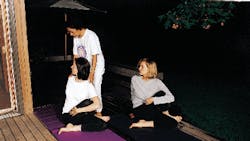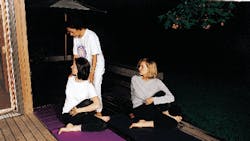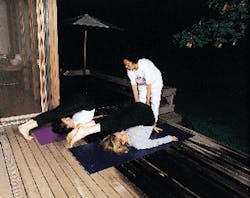The union of mind and body in yoga forges a quiet and relaxing healing process
Mary Martha Stevens, RDH, PhD
Yoga means union - union between the mind, body, and spirit, as well as union between activity and silence. For many, yoga represents a way to gain greater mental and physical flexibility and self-awareness. In Rockford, Ill., yoga also means the union of three dental hygienists who work together and then take time each week to attend a class in the ancient discipline of Hatha Yoga.
Jody Bann, RDH, Susan Taylor, RDH, and Min Thienemann, RDH, meet at Taylor`s home for one to two hours every Tuesday evening to stretch and bend away the stress of their daily lives. Bann, who has been attending the class for seven months, said yoga "allows me to experience quiet time."
"We do a lot of deep breathing during the poses, and this slows down and relaxes my mind and body," Bann says. "The stretches feel so good. Concentrating on breathing while stretching helps me to forget about the stress of the day and the little things that have been bothering me. After class, my mind is calm, clear, and alert."
Taylor added that yoga was not difficult to learn. "I`m not an athletic person. I`ve never really exercised before, even though I have always gardened."
"Yoga is like a massage for every organ in the body," Taylor says. "Afterwards, I feel relaxed and yet very much alive. It`s helped me to become more aware of my body. And I think for someone my age - I`m 58 years old and have practiced in the same dental office for 36 years - the stretching has really helped my arthritis. It has strengthened all the muscles that support the bones, so it`s been very beneficial for me. Our patient load is heavy, and yet I feel my stamina has increased."
Bann became a student of yoga because she thought it would help her become more flexible and have less back tension. She had been having back problems for four years prior to the class. She now says the problem has diminished.
"Yoga has strengthened my stomach and back muscles and made me more aware of my posture," Bann says. "I`m more aware of how I carry myself throughout the day. I feel more in touch with things around me. I`m more at peace with myself."
That calmness and awareness is something that she says extends beyond the class into her every day experiences. "I`m finding that things that use to bother me at work don`t seem to bother me as much anymore," she says.
Although this was not Thienemann`s first yoga class, she feels the teacher and the small class size have made a big difference for her. "Our teacher works on strengthening areas of the body that we are having problems with," she says. "Now I will take a break at work and go through the shoulder-relaxing movements that we learned in class to relieve the discomfort in my shoulder. Both my shoulder and elbow problems are better since I`ve been in the class. Our teacher, Bina, has given us great confidence that we can help our bodies heal as well as prevent injuries."
The instructor, Bina Holland, says she is "still a student of yoga myself, although I`ve been studying it for over 18 years."
Holland said she was motivated to learn yoga because her parents died of high blood pressure. "I was at-risk," she says, "but now my blood pressure is significantly lower."
Holland`s perceptions about professionals in dental hygiene include: "From what I can see, dental hygienists have tense shoulders. So, I try to teach them to relax this area of the body. When the shoulders are tense, this means that oxygen can`t get to this area of the body. By squeezing and relaxing the shoulders, blood is increased in this area which helps to relieve the problem."
Yoga comes from the oldest science of physical and mental health, which was recorded in India more than 5,000 years ago. The poses stretch, strengthen and purify the physical body, which then has a positive effect on the mind also.
Dr. Hari Sharma, professor of pathology and director, Cancer Prevention and Natural Products Research at The Ohio State University College of Medicine, comments in his book, Freedom from Disease: "These exercises stimulate blood flow. Seated poses create stability and proper spinal alignment. Forward bends stimulate digestion, increase the spine`s flexibility, and calm the body. Backbends also create spinal flexibility. Inverted poses stimulate the endocrine system and allow for increased circulation. Twisting poses aid digestion and elimination, and tone the spinal column."
Sharma also comments, "Vedic exercises are always done easily and in a relaxed way, with no attempt to push or force. They are not gymnastics, intended to race the body and tire it out. Rather, they are precise movements and poses which both relax and enliven the body, increasing energy rather than exhausting it."
According to Sharma, research conducted in India has verified the following benefits of yoga exercises:
- Physical relaxation
- Reduced blood pressure
- Increased alpha waves in the brain (which indicates a relaxed yet alert state of mind)
- Reduced cholesterol levels
- Biochemical changes indicative of a healthier autonomic nervous system
- Reduction in being overweight
- Improved eyesight
- Improved appetite
- Less need for sleep
- Improved memory and intellect
- Reduced incidence of the common cold
- Improved rheumatoid arthritis
Tom Jacobs, a yoga instructor in Olathe, Kan., learned yoga in 1979 and then began teaching it in 1988 in hospitals and churches throughout the greater Kansas City area. Jacobs says his "students" include lawyers, psychiatrists, nurses, mothers, educators, carpenters, and corporate workers.
"Yoga teaches people to relax in the midst of tension," he says. "When people bend over in a stretching position, the question that yoga always presents is: How can we bring the lower back and the hamstrings into a state of relaxation, even when they`re tense?"
So two techniques are taught, Jacobs says. Students are told to breathe deeply. "Really deep," Jacobs adds for emphasis. Secondly, people are taught to massage tight muscles with their mind, not their hands. The deep breathing and mental massage are two techniques that allow the "transformation to occur."
"This is done in a noncompetitive way," Jacobs continues. "We can`t be attached to what our bodies were like 10 or 15 years ago. We must accept where we are now. People say, `Oh, I can`t do yoga, I`m not limber.` That`s all the more reason to do it! It`s not just the physical limberness that is important; when we teach the mind not to judge, it creates a mental limberness and flexibility so that other possibilities can begin to occur. That`s the beauty of it."
In order to not push too hard during a class session, Jacobs uses the motto, "honor your edge, not your age." He uses an analogy about guitar playing to explain the benefits of using the right amount of tension when performing a stretching posture. When playing a guitar, if the strings are too tight, they will pop. If they`re too loose, they can`t produce a good sound. The right amount of tension is essential. The same is true for the muscles during a stretching pose.
Thienemann thinks that yoga would help other hygienists too. "They shouldn`t feel intimidated by the postures. We only do what we are comfortably able to do without straining. With each class session, we are able to stretch a little farther. But, we never strain ourselves during the process," says Thienemann. She feels however, that it is important to find a class that suits the needs of the student. "Someone just starting out should take a class for beginners."
According to Jacobs, learning yoga in a group is one experience, practicing yoga at home alone is another experience, and learning yoga from a videotape is yet another experience. Most importantly, Jacobs feels that people should create a ritual out of the practice they enjoy, which will produce positive results instead of guilt.
"My goal is to create a bridge between the yoga class environment of peace and relaxation, and everyone`s daily life," concludes Jacobs. "Because if you can find a place of peace when you`re talking to a person you don`t care for, you are changing the planet. That`s the broader perspective of yoga."
"Many of the yoga poses we do are named after animals because stretching is a part of their nature," adds Holland. "Animals instinctively know what`s good for them."
"Yoga changes you from within. Then you automatically become more aware of what`s good for you," says Holland.
Mary Martha Stevens, RDH, PhD, is an RDH consulting editor. For many years, she was manager of health and wellness for Puritan-Bennett Corp. Currently, she is clinical associate professor, UMKC School of Dentistry. She can be contacted by e-mail at [email protected].
Hatha Yoga
In the photo at left, instructor Bina Holland (standing) guides Jody Bann (top) and Susan Taylor (bottom) through the plough pose. The pose strengthens and relaxes the back, neck, and shoulders, helping the body remove excess fat and fatigue. In the photo at right, the two hygienists improve their circulation in the liver, spleen, neck, and shoulders, with the twist pose. (Photography by Rich Zies)


